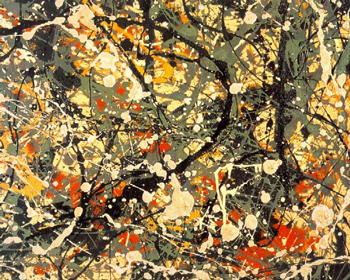
Number 8

|
Number 8, was painted during what is called Pollock's classical period. Indeed, the piece is a pristine and masterful deployment of his passions. The painting also makes clear his biggest influences. His affinity for Mexican muralists such as Rivera, Orozco, and Siqueiros are reflected in the shape of the frame and the relatively large size of the original. And, like the bulk of his work, Number 8, shows a definite surrealist influence, notably the struggle for liberation from preconceived form, something Pollock took, and ran with. While the surrealists clashed with form by depicting the bizarre and impossible, Pollock eschews form in favor of a visual representation of action itself.
Also on prominent display here is Pollock's masterful draftsmanship: that is, his work with lines and lines alone. Pollock consistently maintained remarkable control over his lines. He could quicken a line instantly by thinning it, slow the line by flooding it, always meticulously and consummately executing the changes. This skill is most notable in the silver paint in Number 8: the lines have a lively, dynamic quality, moving about the frame with rapid and surprising changes of rhythm and strength.
Pollock was always conscious of the framing edge of his paintings. Rather than makes a piece that looked like a section of a larger work, with lines freely flowing beyond its boundaries, he limited the field to appropriately fit the canvas. This is richly evident in Number 8, with its seemingly self-contained burst of action and color. The portions of lines that continuously skirt the border of the frame themselves form a sort of secondary border. The movement of the paint also interacts with the edge of the canvas itself: lines swerve to avoid the edge, or touch it and rebound back into the heart of the painting.












